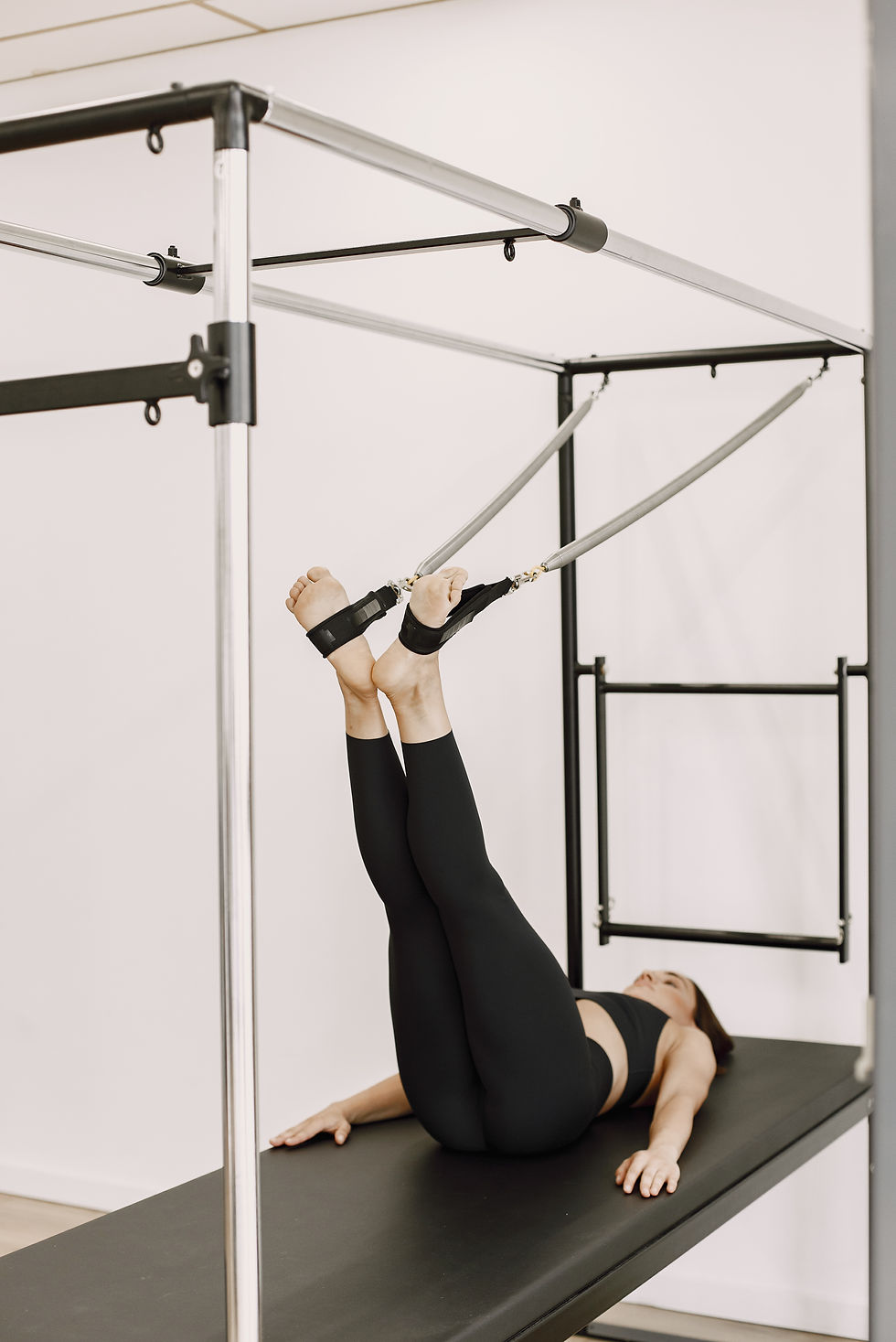Pilates Reformer Machine: Easily Tone Your Body in Just 3 Weeks!
- Hana Rosli
- May 28, 2024
- 4 min read
Updated: Jun 29, 2024
Table of Contents:
Reformer Pilates has surged in popularity, and for good reason. This innovative exercise method promises numerous health benefits, from improved core strength to enhanced flexibility.

However, one question often arises: Is Reformer Pilates hard? In this blog, we'll delve into the workings of the Pilates Reformer machine, exploring its benefits, challenges, and why it's suitable for various fitness levels.
Understanding the Pilates Reformer Machine
The Pilates Reformer machine is a versatile piece of equipment designed to provide a full-body workout. Invented by Joseph Pilates, this apparatus consists of a sliding carriage, adjustable springs, straps, and a footbar.
The machine's design allows for a wide range of exercises that can be adjusted in difficulty to cater to beginners and advanced practitioners alike.
How the Pilates Reformer Machine Works
The Pilates Reformer machine uses a combination of resistance and body weight to create a challenging workout.
The springs can be adjusted to increase or decrease resistance, making the exercises either more demanding or more manageable.

Here’s a breakdown of its components and their functions:
Sliding Carriage: This platform moves back and forth along the frame, supporting your body during exercises.
Springs: Adjustable springs provide resistance, which can be tailored to your strength and fitness level.
Straps and Handles: These are used for pulling and pushing, engaging various muscle groups.
Footbar: A stable surface for foot or hand placement, facilitating a range of movements.
Is Reformer Pilates Hard?
The difficulty of Reformer Pilates largely depends on several factors: your fitness level, the exercise's complexity, and the resistance settings.
Here’s a closer look at what makes Reformer Pilates challenging and why it’s also accessible:
Customizable Difficulty
One of the significant advantages of the Pilates Reformer machine is its adaptability. The adjustable springs allow users to modify the resistance, making exercises easier or harder.
Beginners can start with lighter resistance and gradually increase it as they build strength and confidence. Conversely, seasoned practitioners can challenge themselves with higher resistance and more complex movements.
Engages Multiple Muscle Groups
Reformer Pilates is a full-body workout that targets multiple muscle groups simultaneously. This comprehensive engagement can make the exercises feel intense, especially for those new to this type of workout.
Exercises often focus on the core, but they also work the arms, legs, and back, providing a balanced approach to strength training.

Focus on Form and Control
Proper form and control are crucial in Reformer Pilates. Each movement should be performed with precision, which requires concentration and body awareness.
This focus on meticulous execution can be challenging, particularly for those who are accustomed to high-speed workouts where form is less emphasized.
Mind-Body Connection
Reformer Pilates emphasizes the mind-body connection, requiring practitioners to stay mentally engaged throughout their workout.
This aspect can be demanding, as it involves not just physical effort but also mental focus to maintain proper alignment and control.
Benefits of the Pilates Reformer Machine
Despite its challenges, the Pilates Reformer machine offers numerous benefits that make it worth the effort:
Improved Core Strength: Reformer Pilates is renowned for its ability to strengthen the core, which is essential for overall stability and posture.
Enhanced Flexibility: The dynamic stretches involved in Reformer exercises help improve flexibility and range of motion.
Better Posture: Regular practice promotes better alignment and body awareness, contributing to improved posture and reduced pain.
Low-Impact Exercise: The controlled, smooth movements are gentle on the joints, making Reformer Pilates an excellent option for injury prevention and rehabilitation.
Increased Muscle Tone: The resistance provided by the springs helps build lean muscle, leading to a toned and sculpted physique.
Who Can Benefit from Reformer Pilates?

The Pilates Reformer machine is suitable for a wide range of individuals, regardless of their fitness level. Here’s who can benefit from incorporating Reformer Pilates into their routine:
Beginners
Beginners can start with basic exercises and light resistance, gradually progressing as they gain strength and confidence. The Pilates Reformer machine’s adaptability makes it an excellent entry point for those new to fitness.
Athletes
Athletes can use Reformer Pilates to enhance their performance by improving flexibility, strength, and body control. The low-impact nature of the exercises also makes it an ideal complement to high-intensity training, aiding in recovery and injury prevention.
Individuals with Injuries
Reformer Pilates is often used in physical therapy due to its low-impact, controlled movements. It can help individuals recover from injuries by strengthening the muscles around the affected area and promoting proper alignment.
Older Adults
Older adults can benefit from the improved balance, coordination, and flexibility that Reformer Pilates provides. The machine’s customizable resistance levels ensure that exercises can be tailored to suit their fitness levels and needs.
Conclusion
Is Reformer Pilates hard? The answer depends on your perspective and fitness level. While the Pilates Reformer machine can present a challenging workout, its versatility and adaptability make it accessible to everyone, from beginners to advanced practitioners.
With its myriad benefits, including improved core strength, flexibility, and posture, Reformer Pilates is an effective and rewarding exercise method.
Embrace the challenge and experience the transformative effects of the Pilates Reformer machine in your fitness journey.

Comments